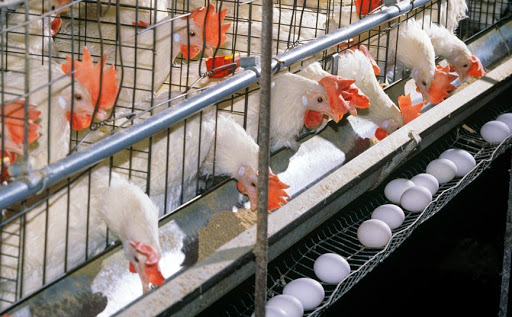

The deep litter system of rearing birds is one of the popular methods embraced by commercial poultry farmers in Uganda. However, the system comes at the expense of big spaces, and a couple of other challenges. The cage system appears to be exactly what every farmer needs. For farmers doing small scale poultry or large scale, the cage system suits both.
The cage system
The cages are a work of metal fabrication, built using nets of stainless steel. It is raised high from the ground and often mobile. They are storied in nature, with each row having compartments where the chicken are housed. This, however, cannot be used as a brooder. Birds have to come into the cage at three months, (roughly up to 15 weeks) of brooding. It is, therefore ,after brooding that the birds are able to be put in the cage. It is a production cage. The birds are put inside the different compartments of the cage, each taking about seven birds.
The cage has a water system that gets water from the cistern – which is also raised above the cage through the different water pipes – to the water outlets found in the cages that release water every time the bird pecks it. This, therefore, means the farmer will not spend on buying drinkers.
Feeds
It also has a provision for feeds; where bran is put and the bird accesses it by inserting its head into the feeding area. This also saves on food wastage since birds cannot step into the feeders to pour the feeds. Additionally, the water does not mix with the feeds, neither can it pour to make the cage dump. The other provision on the cage is the area where the hen lays its eggs – in case the farmer is rearing layers. After laying the egg, it simply rolls through the metallic corridors to the egg section where the birds cannot access them, but also where the farmer can readily pick them without a hustle.
Additionally, with the cage system, the farmer does not need any litter, as it is with the deep litter system. All waste from the birds falls below that cage and from here, the farmer can clean it up.
Senoga also testifies that since he introduced cage housing on his farm, he has significantly reduced on the number of people he employs on the farm. Everything with the cage system is already organised. The feeders are outside the cage, the eggs also come out from inside to where it is convenient to pick them, and the water just needs to be managed from the cistern. Looking after the chicken is thus very easy because one does not have to manoeuvre through the birds to feed and look after them, so the work is easy.
Cost
The cost for these cages is number driven. Depending on the number of birds the farmer wants to keep, and thus, the cages can be custom made. Whereas there are standard cages that can house up to 160 birds, cages can be tailor made basing on what the farmer prefers. They are also expandable in nature that in case a farmer needs to rear more birds, they can keep adding more cages.
The 160 bird cage is at Shs2m, though this might change according to where one decides to buy the cage. Caging is more suitable for layers, and not broilers or indigenous chicken which tend to grow too big for the cubicles in the cages.
Pros and Cons
Pros
– In battery cage, greater number of birds are reared per unit area.
– Requires relatively smaller space which removes the issue of finding a large piece of land to rear poultry.
– Birds spend minimal energy and lessen the load of excess body heat. This energy is instead directed towards egg production
Cons
– Feeding management in cages has to be carefully considered since many farmers mostly rely on mash or crumbs for production.
– Battery cage is associated with higher incidences of leg problem, cage fatigue, fatty liver syndrome which is increased deposition of fat in the body.
– This system requires higher maintenance costs as one has to deal with things like mechanical faults.
 Contact Jaguza Support
Contact Jaguza Support